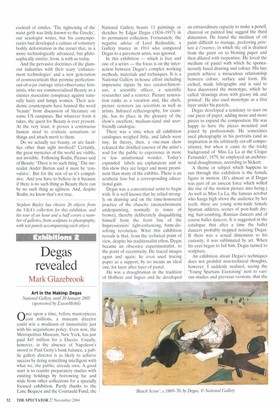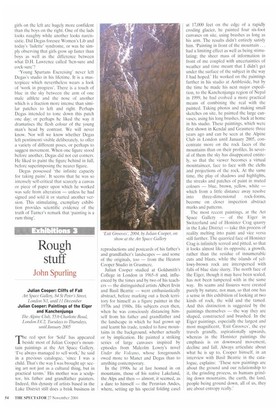Degas revealed
Mark Glazebrook
Art in the Making: Degas National Gallery, until 30 January 2005 (sponsored by ExxonMobil)
Once upon a time, before masterpieces cost millions, a museum director could win a modicum of immortality just with his acquisitions policy. Even now, the Metropolitan Museum, New York, has just paid $45 million for a Duccio. Usually, however, in the absence of Napoleon's sword or Paul Getty's bank balance, a public gallery director is as likely to achieve success by doing something intelligent with what we, the public, already own. A good start is to reunite preparatory studies with existing holdings by borrowing far and wide from other collections for a specially focused exhibition. Partly thanks to the Lane Bequest and the Courtauld Fund, the
National Gallery boasts 11 paintings or sketches by Edgar Degas (1834-1917) in its permanent collection. Fortunately, the negative advice of Lord Redesdale, a Gallery trustee in 1914 who compared Degas to a pavement artist, was ignored.
In this exhibition — which is free and one of a series — the focus is on the interaction between Degas's complex working methods, materials and techniques. It is a National Gallery in-house effort including impressive inputs by two curator/historians, a scientific officer, a scientific researcher and a restorer. Picture restoration ranks as a vocation and, like chefs, picture restorers are scientists as well as artists. Infrared rcflectography, for example, has its place in the glossary of the show's excellent, medium-sized and userfriendly catalogue.
There was a time when all exhibition catalogues weighed little, and labels were tiny. In theory, then, a one-man show released the distilled essence of the artist's soul for the public to experience in more or less uninformed wonder. Today's expanded labels are explanatory and in this show they are larger and more prominent than many of the exhibits. There is an aesthetic loss but a corresponding educational gain.
Degas was a conventional artist to begin with. It is well known that he relied strongly on drawing and on the time-honoured practice of the ebauche (monochromatic underpainting, normally in tones of brown), thereby deliberately disqualifying himself from the front line of the Impressionists' light-enhancing, form-dissolving revolution. What this exhibition reveals is that, from the technical point of view, despite his traditionalist ethos, Degas became an obsessive experimentalist, to the point of eccentricity. He traced images again and again; he even used tracing paper as a support, by no means an ideal one, for layer after layer of pastel.
He was a draughtsman in the tradition of Holbein and Ingres and he developed
an extraordinary capacity to make a pencil, charcoal or painted line suggest the third dimension. He found the medium of oil paint difficult to manage, preferring peintare a l'essence, in which the oil is drained from the paint on to blotting paper and then diluted with turpentine. He loved the medium of pastel with which he spontaneously fused drawing and colour. His late pastels achieve a miraculous relationship between colour, surface and form. He etched, made lithographs and is said to have discovered the nionotype, which he called 'drawings done with greasy ink and printed'. He also used monotype as a first layer under his pastels.
Degas developed a tendency to start on one piece of paper, adding more and more pieces to expand the composition. He was happy to have the pieces mounted and joined by professionals. He sometimes used photography in his portraits (and as inspiration in his arbitrarily cut-off compositions), but when it came to the tricky background of 'Miss La La at the Cirque Fernando', 1879, he employed an architectural draughtsman, according to Sickert.
A theme or subject which happens to run through this exhibition is the female figure in motion. (It's almost as if Degas was part of an unseen force which willed the rise of the motion picture into being.) As well as Miss La La, the famous acrobat who hangs high above the audience by her teeth, there are young semi-nude female Spartan athletes, scenes of post-bath drying, hair-combing, Russian dancers and of course ballet dancers. It is suggested in the catalogue that after a time the ballet dancers probably stopped noticing Degas. If there was a sexual dimension to his curiosity, it was sublimated by art. When his eyes began to fail him, Degas turned to sculpture.
An exhibition about Degas's techniques does not prohibit non-technical thoughts, however. I suddenly realised, seeing the 'Young Spartans Exercising' next to various studies Lind previous versions, that the
girls on the left are hugely more confident than the boys on the right. One of the lads looks naughty while another looks narcissistic. Did Degas foresee Women's Lib and today's ladette' syndrome, or was he simply observing that girls grow up faster than boys as well as the difference between what D.H. Lawrence called 'hen-sure and cock-sure"!
'Young Spartans Exercising' never left Degas's studio in his lifetime. it is a masterpiece which nevertheless wears a look of 'work in progress'. There is a touch of blue in the sky between the arm of one male athlete and the nose of another which is a fraction more intense than similar patches to left and right. Perhaps Degas intended to tone down this patch (me day; or perhaps he liked the way it dramatises the flesh colour of the young man's head by contrast. We will never know. Nor will we know whether Degas left pentirnenti visible deliberately, to offer a variety of different poses, or perhaps to suggest movement. When one figure stood before another, Degas did not cut corners. He liked to paint the figure behind in full, before superimposing the nearer figure.
Degas possessed 'the infinite capacity for taking pains'. It seems that he was so intensely self-critical that scarcely a canvas or piece of paper upon which he worked was safe from alteration — unless he had signed and sold it or started another version. This stimulating, exemplary exhibition provides scientific evidence of the truth of Turner's remark that 'painting is a rum thing'.



















































































 Previous page
Previous page